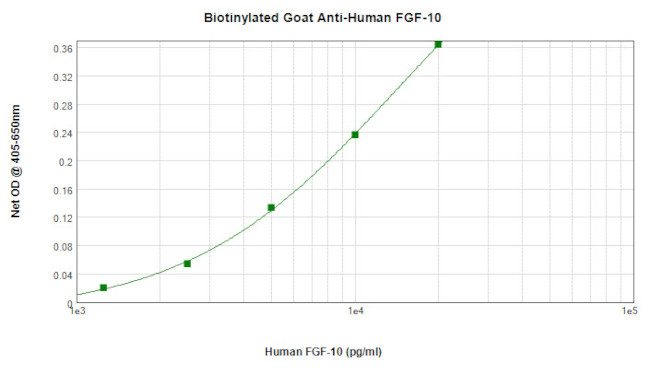Search Thermo Fisher Scientific
FIGURE: 1 / 1
FGF10 Antibody (500-P151GBT-25UG) in ELISA

Product Details
500-P151GBT-25UG
Species Reactivity
Host/Isotype
Class
Type
Immunogen
Conjugate
Form
Concentration
Purification
Storage buffer
Contains
Storage conditions
Shipping conditions
RRID
Product Specific Information
AA Sequence of recombinant protein: MLGQDMVSPE ATNSSSSSFS SPSSAGRHVR SYNHLQGDVR WRKLFSFTKY FLKIEKNGKV SGTKKENCPY SILEITSVEI GVVAVKAINS NYYLAMNKKG KLYGSKEFNN DCKLKERIEE NGYNTYASFN WQHNGRQMYV ALNGKGAPRR GQKTRRKNTS AHFLPMVVHS.
Preparation: Produced from sera of goats immunized with highly pure Recombinant Human FGF-10. Anti-Human FGF-10-specific antibody was purified by affinity chromatography and then biotinylated.
Sandwich ELISA: To detect Human FGF-10 by sandwich ELISA (using 100 µL/well antibody solution) a concentration of 0.25-1.0 µg/mL of this antibody is required. This biotinylated polyclonal antibody, in conjunction with PeproTech Polyclonal Anti-Human FGF-10 (500-P151G) as a capture antibody, allows the detection of at least 0.2-0.4 ng/well of Recombinant Human FGF-10.
Western Blot: To detect hFGF-10 by Western Blot analysis this antibody can be used at a concentration of 0.1-0.2 µg/mL. Used in conjunction with compatible secondary reagents the detection limit for Recombinant hFGF-10 is 1.5-3.0 ng/lane, under either reducing or non-reducing conditions.
500-P151GBT-1MG will be provided as 2 x 500 µg
Target Information
FGF10 is a member of the fibroblast growth factor (FGF) family. FGF family members possess broad mitogenic and cell survival activities, and are involved in a variety of biological processes, including embryonic development, cell growth, morphogenesis, tissue repair, tumor growth and invasion. This protein exhibits mitogenic activity for keratinizing epidermal cells, but essentially no activity for fibroblasts, which is similar to the biological activity of FGF7. Studies of the mouse homolog of suggested that this gene is required for embryonic epidermal morphogenesis including brain development, lung morphogenesis, and initiation of lim bud formation. This protein is also implicated to be a primary factor in the process of wound healing.
For Research Use Only. Not for use in diagnostic procedures. Not for resale without express authorization.
References (0)
Bioinformatics
Protein Aliases: FGF; FGF-10; Fibroblast growth factor; Fibroblast growth factor 10; Keratinocyte growth factor 2; produced by fibroblasts of urinary bladder lamina propria
Gene Aliases: FGF10
UniProt ID: (Human) O15520
Entrez Gene ID: (Human) 2255

Performance Guarantee
If an Invitrogen™ antibody doesn't perform as described on our website or datasheet,we'll replace the product at no cost to you, or provide you with a credit for a future purchase.*
Learn more
We're here to help
Get expert recommendations for common problems or connect directly with an on staff expert for technical assistance related to applications, equipment and general product use.
Contact tech support
